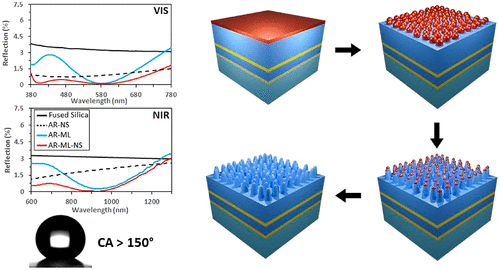当前位置:
X-MOL 学术
›
ACS Photonics
›
论文详情
Our official English website, www.x-mol.net, welcomes your
feedback! (Note: you will need to create a separate account there.)
Antireflective Multilayer Surface with Self-Cleaning Subwavelength Structures
ACS Photonics ( IF 6.5 ) Pub Date : 2021-02-17 , DOI: 10.1021/acsphotonics.0c01909 Juan Rombaut 1 , Sofía Martínez 1 , Umberto Maria Matera 1 , Prantik Mazumder 2 , Valerio Pruneri 1, 3
ACS Photonics ( IF 6.5 ) Pub Date : 2021-02-17 , DOI: 10.1021/acsphotonics.0c01909 Juan Rombaut 1 , Sofía Martínez 1 , Umberto Maria Matera 1 , Prantik Mazumder 2 , Valerio Pruneri 1, 3
Affiliation

|
The suppression of optical reflection from a surface is essential in many applications, ranging from displays with reduced disturbance from ambient light to high-efficiency photovoltaic cells and stable light detection and ranging (LIDAR) systems. Traditionally, antireflection (AR) surfaces are made of multilayer (ML) coatings that produce destructive interference of light beams reflected from each interface. More advanced AR surfaces are based on biomimetic nanostructures (NS) that rely on a gradation of refractive index to suppress reflection. While AR-ML coatings tend to work for restricted light wavelengths and angles of incidence, AR-NS can be broadband and omnidirectional. In addition, AR-NS can provide superhydrophobicity and self-cleaning effects. Unfortunately, AR-NS often suffer from mechanical failure, this being more critical for taller structures required for operation at longer wavelengths. Here we propose to combine ML and shorter NS to achieve an AR surface with several crucial advantages, including greater spectral and angular bandwidth and water repellency compared to only AR-ML, easier fabrication, lower scattering, and higher mechanical durability compared to only AR-NS, which requires taller structures. We present theoretical and experimental studies for combined AR-ML-NS glass surfaces operating in the visible (VIS) between 380 and 780 nm and especially at longer wavelengths in the near-infrared (NIR) at around 900 nm, where applications such as LIDAR for autonomous vehicles are of high interest.
中文翻译:

具有自清洁亚波长结构的抗反射多层表面
在许多应用中,抑制从表面反射的光是必不可少的,从降低环境光干扰的显示器到高效光伏电池以及稳定的光检测和测距(LIDAR)系统。传统上,防反射(AR)表面由多层(ML)涂层制成,会对从每个界面反射的光束产生相消干涉。更高级的AR表面基于仿生纳米结构(NS),该仿生纳米结构依赖于折射率的渐变来抑制反射。虽然AR-ML涂层往往适用于受限制的光波长和入射角,但AR-NS可以是宽带的,并且是全向的。另外,AR-NS可以提供超疏水性和自清洁效果。不幸的是,AR-NS经常会遭受机械故障的困扰,这对于在更长波长下工作所需的较高结构来说更为关键。在这里,我们建议将ML和更短的NS结合起来,以获得具有几个关键优势的AR表面,与仅AR-ML相比,它具有更大的光谱和角度带宽以及疏水性,更容易制造,更低的散射以及更高的机械耐久性。 NS,需要更高的结构。我们目前针对在380 nm至780 nm之间的可见光(VIS)中工作的AR-ML-NS组合玻璃表面进行理论和实验研究,尤其是在900 nm附近的近红外(NIR)中更长的波长下工作,如LIDAR等应用对自动驾驶汽车的关注度很高。在这里,我们建议将ML和更短的NS结合起来,以获得具有几个关键优势的AR表面,与仅AR-ML相比,它具有更大的光谱和角度带宽以及疏水性,更容易制造,更低的散射以及更高的机械耐久性。 NS,需要更高的结构。我们目前针对在380 nm至780 nm之间的可见光(VIS)中工作的AR-ML-NS组合玻璃表面进行理论和实验研究,尤其是在900 nm附近的近红外(NIR)中更长的波长下工作,如LIDAR等应用对自动驾驶汽车的关注度很高。在这里,我们建议将ML和更短的NS结合起来,以获得具有几个关键优势的AR表面,与仅AR-ML相比,它具有更大的光谱和角度带宽以及疏水性,更容易制造,更低的散射以及更高的机械耐久性。 NS,需要更高的结构。我们目前针对在380 nm至780 nm之间的可见光(VIS)中工作的AR-ML-NS组合玻璃表面进行理论和实验研究,尤其是在900 nm附近的近红外(NIR)中更长的波长下工作,如LIDAR等应用对自动驾驶汽车的关注度很高。需要更高的结构。我们目前针对在380 nm至780 nm之间的可见光(VIS)中工作的AR-ML-NS组合玻璃表面进行理论和实验研究,尤其是在900 nm附近的近红外(NIR)中更长的波长下工作,如LIDAR等应用对自动驾驶汽车的关注度很高。需要更高的结构。我们目前针对在380至780 nm之间的可见光(VIS)中工作的AR-ML-NS组合玻璃表面进行理论和实验研究,尤其是在900 nm左右的近红外(NIR)中更长的波长下工作,如LIDAR等应用对自动驾驶汽车的关注度很高。
更新日期:2021-03-17
中文翻译:

具有自清洁亚波长结构的抗反射多层表面
在许多应用中,抑制从表面反射的光是必不可少的,从降低环境光干扰的显示器到高效光伏电池以及稳定的光检测和测距(LIDAR)系统。传统上,防反射(AR)表面由多层(ML)涂层制成,会对从每个界面反射的光束产生相消干涉。更高级的AR表面基于仿生纳米结构(NS),该仿生纳米结构依赖于折射率的渐变来抑制反射。虽然AR-ML涂层往往适用于受限制的光波长和入射角,但AR-NS可以是宽带的,并且是全向的。另外,AR-NS可以提供超疏水性和自清洁效果。不幸的是,AR-NS经常会遭受机械故障的困扰,这对于在更长波长下工作所需的较高结构来说更为关键。在这里,我们建议将ML和更短的NS结合起来,以获得具有几个关键优势的AR表面,与仅AR-ML相比,它具有更大的光谱和角度带宽以及疏水性,更容易制造,更低的散射以及更高的机械耐久性。 NS,需要更高的结构。我们目前针对在380 nm至780 nm之间的可见光(VIS)中工作的AR-ML-NS组合玻璃表面进行理论和实验研究,尤其是在900 nm附近的近红外(NIR)中更长的波长下工作,如LIDAR等应用对自动驾驶汽车的关注度很高。在这里,我们建议将ML和更短的NS结合起来,以获得具有几个关键优势的AR表面,与仅AR-ML相比,它具有更大的光谱和角度带宽以及疏水性,更容易制造,更低的散射以及更高的机械耐久性。 NS,需要更高的结构。我们目前针对在380 nm至780 nm之间的可见光(VIS)中工作的AR-ML-NS组合玻璃表面进行理论和实验研究,尤其是在900 nm附近的近红外(NIR)中更长的波长下工作,如LIDAR等应用对自动驾驶汽车的关注度很高。在这里,我们建议将ML和更短的NS结合起来,以获得具有几个关键优势的AR表面,与仅AR-ML相比,它具有更大的光谱和角度带宽以及疏水性,更容易制造,更低的散射以及更高的机械耐久性。 NS,需要更高的结构。我们目前针对在380 nm至780 nm之间的可见光(VIS)中工作的AR-ML-NS组合玻璃表面进行理论和实验研究,尤其是在900 nm附近的近红外(NIR)中更长的波长下工作,如LIDAR等应用对自动驾驶汽车的关注度很高。需要更高的结构。我们目前针对在380 nm至780 nm之间的可见光(VIS)中工作的AR-ML-NS组合玻璃表面进行理论和实验研究,尤其是在900 nm附近的近红外(NIR)中更长的波长下工作,如LIDAR等应用对自动驾驶汽车的关注度很高。需要更高的结构。我们目前针对在380至780 nm之间的可见光(VIS)中工作的AR-ML-NS组合玻璃表面进行理论和实验研究,尤其是在900 nm左右的近红外(NIR)中更长的波长下工作,如LIDAR等应用对自动驾驶汽车的关注度很高。











































 京公网安备 11010802027423号
京公网安备 11010802027423号